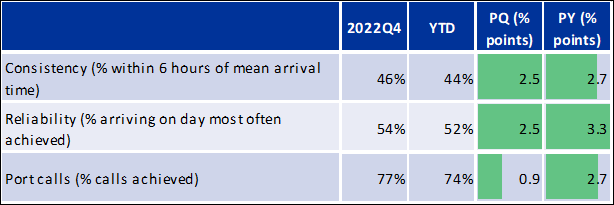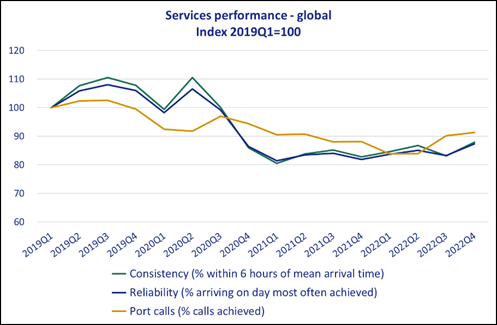
Containerised cargo volumes moved in the deep-sea container shipping market fell a further 2.5% during the final quarter of 2022, marking the traditionally busiest period of the year as the 'peak season without a peak,' according to a new analysis by Global Shippers Forum (GSF).
It said volumes had fallen steadily in the early weeks of 2023, and world trade continues to stumble as economies grapple with persistent inflation and high energy prices, suppressing consumer demand for goods across nearly all economic sectors.
Commenting on the publication of the latest GSF/MDS Transmodal Container Shipping Market Review, James Hookham, Secretary General of Global Shippers Forum, said: "This has stopped being just a supply chain or a shipping issue, and shippers and carriers are firmly in the hands of global economic forces which are themselves responding to structural weaknesses in economies and to geopolitical tensions."
"Predicting volumes and inventory requirements for the remainder of the year is a leap into the unknown for many shippers, as few but the most experienced will have encountered so varied a mix of influencing factors," he added.
With interest rates still high and Central Banks hinting they could go higher still, the inflationary effects of the Covid crisis and the crunch on consumer spending are lingering into the second quarter of this year.
Demand recovery in H2 a "hope"


Source: GSF/MDS Transmodal Container Shipping Market Review
The report said on the demand side, many carriers and service providers are anticipating a recovery in demand in the second half of the year, but this is more in hope than expectation — there are few economic signals to support such optimism.
The GSF/MDS Transmodal Container Shipping Market Review noted that the arrival of new shipping capacity, an apparent questioning of the benefits of shipping alliances and an inevitable reduction in utilisation of vessel space, is also "changing the shape of the supply side of the equation in container shipping."
"Shippers have undoubtedly benefitted from the dramatic fall in spot rates over the past nine months, with costs on many routes back to pre-Covid levels. But weak demand for their core products will be of more concern to shippers than the cost of their shipment," the report said.
"Whilst wary of the speed at which demand could recover — as seen in 2020 — many shippers are bracing for a bounce in rates that may not arrive for some time," it added.
The GSF/MDS Transmodal Container Shipping Market Review also noted that shippers have also seen a sharp improvement in port call predictability, with the number of scheduled calls actually made by vessels significantly improved over Q3 2022.
This is the first time since the reviews started in 2020 that the Service Quality Indicators have all been positive, albeit from a low base, the report said.
"This time, it's certainly different! How shipping lines respond to weak demand, manage existing surplus capacity, deploy new vessels and maintain port schedules, all in a year when every existing ship is being assessed for its overall fuel efficiency will remain a key focus for our monitoring of the market," Hookham pointed out.
"The dollar value of rates may look the same as 2019, but the market conditions are utterly different and even less predictable," he added.
For his part, Mike Garratt, chairman of MDS Transmodal, said, "demand clearly fell while shipping line capacity grew marginally, improving shippers' negotiating positions."
"Performance generally improved as rates fell and the return of more multi-regional services improved connectivity between markets. However, mean revenues per TEU remained high relative to costs as a consequence of the contract rates agreed the previous year, which is reflected in published liner company results for 2022," he added.
"Several consortia continued to enjoy market shares of above 30%," the chair of the MDS Transmodal further said.



